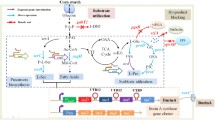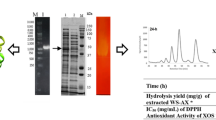Abstract
The enhancement of enzyme complex produced by Penicillium echinulatum grown in several culture media components (bagasse sugarcane pretreated by various methods, soybean meal, wheat bran, sucrose, and yeast extract) was studied to increment FPase, xylanase, pectinase, and β-glucosidase enzyme activities. The present results indicated that culture media composed with 10 g/L of the various bagasse pretreatment methods did not have any substantial influence with respect to the FPase, xylanase, and β-glucosidase attained maximum values of, respectively, 2.68 FPU/mL, 2.04, and 115.4 IU/mL. On the other hand, proposed culture media to enhance β-glucosidase production composed of 10 g/L steam-exploded bagasse supplemented with soybean flour 5.0 g/L, yeast extract 1.0 g/L, and sucrose 10.0 g/L attained, respectively, 3.19 FPU/mL and 3.06 IU/mL while xylanase was maintained at the same level. The proteomes obtained from the optimized culture media for enhanced FPase, xylanase, pectinase, and β-glucosidase production were analyzed using mass spectrometry and a panel of GH enzyme activities against 16 different substrates. Culture medium designed to enhance β-glucosidase activity achieved higher enzymatic activities values (13 measured activities), compared to the culture media for FPase/pectinase (9 measured activities) and xylanase (7 measured activities), when tested against the 16 substrates. Mass spectrometry analyses of secretome showed a consistent result and the greatest number of spectral counts of Cazy family enzymes was found in designed β-glucosidase culture medium, followed by FPase/pectinase and xylanase. Most of the Cazy identified protein was cellobiohydrolase (GH6 and GH7), endoglucanase (GH5), and endo-1,4-β-xylanase (GH10). Enzymatic hydrolysis of hydrothermally pretreated sugarcane bagasse performed with β-glucosidase enhanced cocktail achieved 51.4 % glucose yield with 10 % w/v insoluble solids at enzyme load of 15 FPU/g material. Collectively the results demonstrated that it was possible to rationally modulate the GH activity of the enzymatic complex secreted by P. echinulatum using adjustment of the culture medium composition. The proposed strategy may contribute to increase enzymatic hydrolysis of lignocellulosic materials.



Similar content being viewed by others
References
Ahamed A, Vermette P (2009) Effect of culture medium composition on Trichoderma reesei morphology and cellulase production. Bioresour Technol 100:5979–5987
Bailey MJ, Biely P, Poutanen K (1992) Interlaboratory testing of methods for assay of xylanase activity. J Biotechnol 23:257–270
Berlin A, Maximenko V, Gilkes N, Saddler J (2007) Optimization of enzyme complexes for lignocellulose hydrolysis. Biotechnol Bioeng 97:287–296
Bradford MM (1976) A rapid and sensitive method for the quantification of microgram quantities of protein utilizing the principle of protein-dye binding. Anal Biochem 72:248–254
Broda P (1992) Biotechnology in the degradation and utilization of lignocellulose. Biodegradation 3:219–238
Brotolassi JR, Santos GT, Alcalde CR, Gonçalves GD, Zambom MA, Furlan AC (2000) Comparação do método convencional e Filter Bag Technique da Ankom (FBT) para determinação de fibra em detergente neutro e fibra em detergente ácido. Acta Scientiarum 22:807–811
Cannella D, Jorgensen H (2013) Do new cellulolytic enzyme preparations affect the industrial strategies for high solids lignocellulosic ethanol production? Biotechnol Bioeng 111:59–68
Delabona PS, Cota J, Hoffmam ZB, Paixao DA, Farinas CS, Cairo JP, Pradella JGC (2013) Understanding the cellulolytic system of Trichoderma harzianum P49P11 and enhancing saccharification of pretreated sugarcane bagasse by supplementation with pectinase and alpha-l-arabinofuranosidase. Bioresour Technol 131:500–507
Delabona PS, Farinas CS, Lima DJS, Pradella JGC (2012) Experimental mixture design as a tool to enhance glycosyl hydrolases production by a new Trichoderma harzianum P49P11 strain cultivated under controlled bioreactor submerged fermentation. Bioresour Technol 132:401–405
Delabona PS, Farinas CS, Silva MR, Azzoni SF, Pradella JGC (2012) Use of a new Trichoderma harzianum strain isolated from the Amazon rainforest with pretreated sugar cane bagasse for on-site cellulase production. Bioresour Technol 107:517–521
Dillon AJ, Bettio M, Pozzan FG, Andrighetti T, Camassola M (2011) A new Penicillium echinulatum strain with faster cellulase secretion obtained using hydrogen peroxide mutagenesis and screening with 2-deoxyglucose. J Appl Microbiol 111:48–53
Domingues FC, Queiroz JA, Cabral JMS, Fonseca LP (2000) The influence of culture conditions on mycelial structure and cellulose production by Trichoderma reesei Rut C-30. Enzyme Microbial Technol 26:394–401
Ghose TK (1987) Measurement of cellulase activities. Pure Appl Chem 59:257–268
Gusakov AV (2011) Alternatives to Trichoderma reesei in biofuel production. Trends Biotechnol 29:419–435
Horta MAC, Vicentini R, Delabona PS, Laborda P, Crucello A, Freitas S, Kuroshu RM, Polikarpov I, Pradella JGC, Souza AP (2014) Transcriptome profile of Trichoderma harzianum IOC-3844 induced by sugarcane bagasse. PLoS One 9(2):e88689
Kadam K (1996) Cellulase production. In: Wyman C (ed) Handbook on bioethanol: production and utilization. Taylor & Francis, Washington, DC, pp 231–252
Klass DL (1988) Biomass for renewable energy, fuels, and chemicals. Academic Press, San Diego
Mandels M, Reese ET (1957) Induction of cellulase in Trichoderma viride as influenced by carbon sources and metals. J Bacteriol 73(2):269–278
Menegol D, Scholl AL, Fontana RC, Dillon AJP, Camassola M (2014) Potential of a Penicillium echinulatum enzymatic complex produced in either submerged or solid-state cultures for enzymatic hydrolysis of elephant grass. Fuel 133:232–240
Miller GL (1959) Use of dinitrosalicylic acid reagent for determination of reducing sugar. Anal Chem 31:426–428
Navya PN, Pushpa SM (2012) Production, statistical optimization and application of endoglucanase from Rhizopus stolonifer utilizing coffee husk. Bioprocess Biosyst Eng 36:1115–1123
Pandey A, Soccol CR, Nigam P, Soccol VT (2000) Biotechnological potential of agro-industrial residues. I: sugarcane bagasse. Bioresour Technol 74:69–80
Pandey A (2003) Solid state fermentation. Biochem Eng J 13:81–84
Pereira BMP, Alvarez TM, Delabona PS, Dillon AJP, Squina FM, Pradella JGC (2013) On-site production from sugar cane bagasse using Penicillium echinulatum. Bioenerg Res 6:1052–1062
Radhika D, Murugesan AG (2012) Bioproduction, statistical optimization and characterization of microbial plastic (poly 3-hydroxy butyrate) employing various hydrolysates of water hyacinth (Eichhornia crassipes) as sole carbon source. Bioresour Technol 121:83–92
Reis LF, Fontana RC, Delabona PS, Lima DJS, Camassola M, Pradella JGC, Dillon AJ (2013) Increased production of cellulases and xylanases by Penicillium echinulatum S01M29 in batch and fed-batch culture. Bioresour Technol 146:597–603
Reis LR, Schneider WDH, Camassola M, Dillon AJP (2014) Cellulase and xylanase expression in response to different pH levels of Penicillium echinulatum S01M29 medium. Bioenerg Res 7:60–67
Ribeiro DA, Cota J, Alvarez TM, Brüchi F, Bragato J, Pereira BMP, Pauletti BA et al (2012) The Penicillium echinulatum secretome on sugar cane bagasse. PLoS One 7:e50571
Ritter CET, Fontana RC, Camassola M, Dillon AJP (2013) The influence of sorbitol on the production of cellulases and xylanases in an airlift bioreactor. Bioresour Technol 148:86–90
Rodriguez-Zuniga UF, Cannella D, Giordano RC, Giordano Jorgensen H, Felby C (2015) Lignocellulose pretreatment technologies affect 1 the level of enzymatic cellulose oxidation by LPMO. Green Chem. doi:10.1039/C4GC02179G
Schneider WDH, dos Reis L, Camassola M, Dillon AJP (2014) Morphogenesis and production of enzymes by Penicillium echinulatum in response to different carbon sources. BioMed Res Int. doi:10.1155/2014/254863
Sheehan J, Himmel M (1999) Enzymes, energy, and the environment: a strategic perspective on the U.S. Department of Energy´s research and development activities for bioethanol. Biotechnol Progr 15:817–827
Suwannarangsee S, Bunterngsook B, Arnthong J, Paemanee A, Thamchaipenet A, Eurwilaichitr L, Laosiripojana N, Champreda V (2012) Optimisation of synergistic biomass-degrading enzyme systems for efficient rice straw hydrolysis using an experimental mixture design. Bioresour Technol 119:252–261
Wang B, Cai P, Sun W, Li J, Tian C, Ma Y (2015) A transcriptomic analysis of Neurospora crassa using five major crop residues and the novel role of the sporulation regulator rca-1 in lignocellulase production. Biotechnol Biofuels 8:21. doi:10.1186/s13068-015-0208-0
Zampieri D, Guerra L, Camassola M, Dillon AJP (2013) Secretion of endoglucanases and β-glucosidases by Penicillium echinulatum 9A02S1 in presence of different carbon sources. Ind Crop Prod 50:882–886
Acknowledgments
The authors thank Conselho Nacional de Desenvolvimento Científico e Tecnológico (CNPq) for financial support. The authors gratefully acknowledge the provision of time at the CNPEM facility MAS at LNBio. The authors also thank Dr AJP Dillon for the strain P. echinulatum S01M29.
Author information
Authors and Affiliations
Corresponding author
Electronic supplementary material
Below is the link to the electronic supplementary material.
Rights and permissions
About this article
Cite this article
dos Santos Costa, P., Büchli, F., Robl, D. et al. Enhancement of Penicillium echinulatum glycoside hydrolase enzyme complex. J Ind Microbiol Biotechnol 43, 627–639 (2016). https://doi.org/10.1007/s10295-016-1746-6
Received:
Accepted:
Published:
Issue Date:
DOI: https://doi.org/10.1007/s10295-016-1746-6




